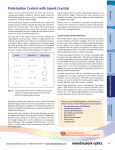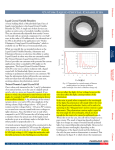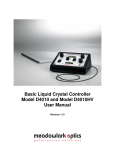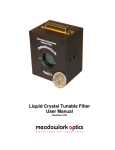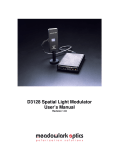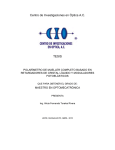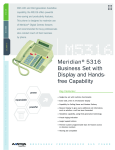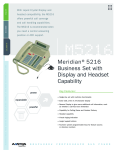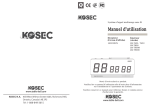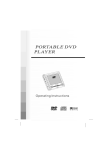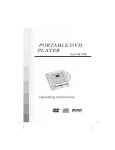Download Liquid Crystal Variable Retarders
Transcript
Polarizers Liquid Crystal Variable Retarders Anisotropic nematic liquid crystal molecules form uniaxial birefringent layers in the liquid crystal cell. An essential feature of nematic material is that, on average, molecules are aligned with their long axes parallel, but with their centers randomly distributed as shown in figure 4-6(a). With no voltage applied, the liquid crystal molecules lie parallel to the glass substrates and maximum retardation is achieved. T hese products all use nematic liquid crystal materials to electrically control polarization. Meadowlark Optics standard liquid crystal products provide tunable retardation by changing the effective birefringence of the material with applied voltage, thus altering the input polarized light to any chosen elliptical, linear or circular polarization. Our precision Liquid Crystal Variable Retarders require unique fabrication and assembly steps. We construct these retarders using optically flat fused silica windows coated with our transparent conductive Indium Tin Oxide (ITO). Our ITO coating is specially designed for maximum transmission from 450 - 1800 nm (see Figure 4.5). A thin dielectric layer is applied over the ITO and gently rubbed, to provide for liquid crystal molecular alignment. Two windows are then carefully aligned and spaced a few microns apart. The cavity is filled with birefringent nematic liquid crystal material. Electrical contacts are attached and the device is environmentally sealed. We carefully place the Liquid Crystal Variable Retarder in an anodized aluminum housing such that the fast and slow axes are both at 45° relative to a convenient mounting hole. Fig. 4-5 Typical transmission through an uncoated liquid crystal device 48 Fused Silica ITO Alignment Layer Spacer LC Molecules (a) Maximum Retardance (V = 0) LC Molecules tipped with applied voltage (b) Minimum Retardance (V >> 0) Fig. 4-6 Liquid Crystal Variable Retarder construction showing molecular alignment (a) without and (b) with applied voltage We achieve zero (or any custom) retardance with a subtractive fixed polymer retarder, called a compensator, attached to the liquid crystal cell. Negative retardance values are sometimes preferred, for example, when converting between right- and left-circularly polarized states. Figure 4-8 illustrates retardance as a function of voltage for a typical Liquid Crystal Variable Retarder with and without an attached compensator. Placing a compensated Liquid Crystal Variable Retarder between two high extinction polarizers creates an excellent optical attenuator, with convenient electronic control. Liquid Crystal Controllers Liquid Crystal Devices Mounting Hardware Retarders When voltage is applied, liquid crystal molecules begin to tip perpendicular to the fused silica windows as shown in figure 4-6(b). As voltage increases, molecules tip further causing a reduction in the effective birefringence and hence, retardance. Molecules at the surface, however, are unable to rotate freely because they are pinned at the alignment layer. This surface pinning causes a residual retardance of ~30 nm even at high voltage (20 volts). As with any anisotropic material, retardance is dependent upon thickness and birefringence. Liquid cr ystal material birefringence depends on operating wavelength, drive voltage and temperature. The overall retardance of a liquid crystal cell decreases with increasing temperature (approximately -0.4% per ºC). www.meadowlark.com • (303) 833-4333 • [email protected] Liquid Crystal Variable Retarders Liquid Crystal Variable Retarder response time depends on several parameters, including layer thickness, viscosity, temperature, variations in drive voltage and surface treatment. Liquid crystal response time is proportional to the square of the layer thickness and therefore, the square of the total retardance. a) Response time improves by using custom materials with high birefringence and a thinner liquid crystal layer. At higher temperature, material viscosity decreases, also contributing to a faster response. For speed critical applications, see page 56 for Swift LC devices. Our standard Liquid Crystal Variable Retarders provide a minimum retardance range of ~30 nm to at least half-wave at the specified wavelength. With an attached compensator, retardance is guaranteed to range from zero to at least half-wave at the specified wavelength. Custom retardance ranges (up to a few waves) and custom compensators are available. Contact our Sales Department to discuss your requirements. b) QUESTION Liquid Crystal Controllers Each Liquid Crystal Variable Retarder is supplied with retardance versus voltage performance data for your specified wavelength. A coaxial cable with mating connector is provided for easy attachment to one of our electronic controllers. Liquid Crystal Devices Another technique involves the Transient Nematic Effect (TNE) to improve response times. With this drive method, a high voltage spike is applied to accelerate the molecular alignment parallel to the applied field. Voltage is then reduced to achieve the desired retardance. When switching from low to high retardance all voltage is momentarily removed to allow the liquid crystal molecules to undergo natural relaxation. Response time achieved with the transient nematic effect is also shown in figure 4-7c. Our Four Channel Digital Interface described on pages 60-61 conveniently provides the necessary TNE voltage profiles. Mounting Hardware Fig.4-7 Temporal response of LC Variable Retarder The applied voltage is a 2 kHz square wave. Excessive DC voltage will damage the liquid crystal Retarders Response time also depends upon direction of the retardance change. If the retardance increases, response time is determined solely by mechanical relaxation of the molecules. If retardance decreases in value, response time is much faster due to the increased electric field across the liquid crystal layer. Typical response time for our standard visible Liquid Crystal Variable Retarder is shown in figure 4-7b. It takes about 5 ms to switch from one-half to zero waves (low to high voltage) and about 20 ms to switch from zero to one-half wave (high to low voltage). Polarizers Response Time “The temporal response of a liquid-crystal device seems very complicated. Where can I find some clarification?” ANSWER Fig.4-8 Liquid Crystal Variable Retarder performance versus applied voltage at 632.8 nm, 21° C. (a) without compensator and (b) with compensator See our Application Note on temporal response of liquid crystal devices at www.meadowlark.com. [email protected] • (303) 833-4333 • www.meadowlark.com 49 Liquid crystal devices should be electrically driven with an AC waveform with no DC component to prevent ionic buildup which can damage the liquid crystal layer. We require a 2 kHz square wave of adjustable amplitude for controlling our Liquid Crystal Variable Retarders (LCVR). Our Basic Controller and Four Channel Interface described on pages 59-61 ensure these drive requirements are met. A temperature sensing and control option can be added to our LCVRs for accurate controlling of the operating temperature. The sensor is attached directly to the LCVR substrate, outside its clear aperture. Without this option, retardance decreases by approximately 0.2% to 0.3% per °C increase in temperature. Key Benefits Fig. 4-9 Model LVR-100 dimensions All dimensions in inches Fig. 4-10 Models LVR-200 and LVR-300 dimensions All dimensions in inches • • • • Computer control capability Temperature control options Usable from 450 to 1800 nm Precision non-mechanical retardation control Liquid Crystal Devices Mounting Hardware Retarders Polarizers Liquid Crystal Variable Retarders SPECIFICATIONS ORDERING INFORMATION Retarder Material Nematic liquid crystal Substrate Material Optical quality synthetic fused silica Wavelength Range 450-1800 nm (specify) Liquid Crystal Controllers Retardance Range 50 Diameter, D (in.) Clear Aperture, CA (in.) Thickness t (in.) Part Number Without Attached Compensator (30 nm to λ/2) 1.00 0.37 1.23 LVR - 100 ~30 nm to λ/2 0 to λ/2 custom ranges are available 2.00 0.70 0.75 LVR - 200 3.00 1.60 1.00 LVR - 300 Transmitted Wavefront Distortion (at 632.8 nm) ≤ λ/4 1.00 0.37 1.23 LRC - 100 Surface Quality 40-20 scratch and dig 2.00 0.70 0.75 LRC - 200 Beam Deviation ≤ 2 arc min 3.00 1.60 1.00 LRC - 300 Reflectance (per surface) ≤ 0.5% at normal incidence Diameter Tolerance ± 0.005 in. Temperature Range 0° C to 50°C We offer standard liquid crystal variable retarders to cover four spectral regions: VIS: 450 - 700 nm IR 1: 650 - 950 nm IR 2: 900 - 1250 nm IR 3: 1200 - 1700 nm Recommended Safe Operating Limit 500 W/cm2, CW 300 mJ/cm2, 10 ns, visible Please specify spectral region when placing your order. For temperature control option, append-TSC to part number . Without compensator With compensator With Attached Compensator (0 nm to λ/2) www.meadowlark.com • (303) 833-4333 • [email protected] NEW Basic B asic Liqu Liquid Crystal Controller • • • Internal Frequency/Voltage 1 Voltage 1 7.000 Voltage 1 Output Each Meadowlark Optics Liquid Crystal Variable Retarder is supplied with a plot of its actual retardance versus voltage. Using your Model D4010 Controller and this retardance plot ensures accurate retardance to voltage correlation. Frequency Internal Voltage 2 Pulse SPECIFICATIONS Voltage 2 Voltage 2 1.500 Error Basic Liquid Crystal Controller Model D4010 Fig. 5-1 Model D4010 Basic Liquid Controller front panel layout With a Liquid Crystal Variable Retarder, manual adjustment of the voltage amplitude controls the device retardance. Figure 4-8 on page 49 illustrates the relationship between voltage and retardance. Independent voltage settings allow easy and repeatable selection of two retardance values. Often, it is desirable to modulate between the two states. For example, switching between quarterwave and half-wave retardance changes linearly polarized light to either left or right circular. A manual toggle allows easy switching between two states. 0 to 20 V rms, maximum Voltage Resolution ± 1 mV for < 10 V output ± 10 mV for ≥ 10 V output Fundamental Drive Waveform 2 kHz ac square wave External Modulation (input) TTL compatible 5 V maximum Output Bias ± 5 mV dc, maximum Power Requirements 100 – 240 V ac 47 – 63 Hz 500 mA Internal Frequency (modulation) 0.5 – 150 Hz 50% duty cycle External Frequency (modulation) DC – 500 Hz, variable duty cycle allowable External Dimensions (W x D x H) 7.0 x 5.0 x 3.0 in. CE Compliance Compliant Liquid Crystal Controllers Meadowlark Optics is excited to announce the release of the Model D4010, our new Basic Liquid Crystal Controller. This liquid crystal (LC) driver is designed to integrate with any single (standard) Meadowlark Optics LC device currently offered as well as any nematic Liquid Crystal device compatible with the specifications listed. Digital LED voltage and frequency readouts provide added convenience. Now, frequency and voltage settings can be easily stored by simply pressing the adjustment knob. Also, system memory retains voltage and frequency settings at power down. Output Voltage Liquid Crystal Devices External Mounting Hardware Model D4010 comes equipped with its own internal modulation control. The Internal Frequency knob adjusts periodic switching between the two voltage settings. An external input allows modulation to run synchronously with other equipment. Retarders • • • • • • • • Convenient, stand-alone bench top operation Versatile - compatible with all standard Meadowlark Optics LC devices and other nematic liquid crystal devices with compatible listed specifications System memory retains voltage and frequency settings at power down Bright green, digital LED voltage and frequency readouts SMA and BNC outputs, with no adapters required Voltage and frequency save and restore function Out-of-the-box functionality. Sets up in minutes. Safe, low voltage operation. Fuse protected. Intuitive operation. Compact. Easy to use. ROHS and CE compliant Low DC bias protects liquid crystal Polarizers Key Benefits: ORDERING INFORMATION Basic LC Controller D4010 Two year and three year extended warranty options available, please contact your Meadowlark Optics sales engineer [email protected] • (303) 833-4333 • www.meadowlark.com 59 Polarizers Four Channel Digital Interface Key Benefits: • • • • • The Four Channel Digital Interface is designed for high precision computer control of up to four Meadowlark Optics nematic liquid crystal devices at one time and is available in either Basic or Advanced Package options. The D3040 Basic comes with CellDRIVE 3000 Basic software to allow independent control of the amplitude of the 2 kHz square wave drive for four separate nematic liquid crystal cells. Liquid Crystal Controllers Liquid Crystal Devices Mounting Hardware Retarders • USB or RS232 interface C++ code examples including .dll libraries Compact and simple to use Microsoft® HyperTerminal configuration file included Independent control of voltage levels on four channels to 1 mV resolution Includes National Instruments LabVIEW™ Virtual Instrument drivers to interface with custom software The D3050 Advanced Package includes all the functionality of the Basic Package plus the added features of the CellDRIVE 3100 Advanced software and capability for temperature monitoring and control on one channel. The Advanced Package allows the amplitude of the 2 kHz square wave output to be driven either by an external DC analog signal supplied to a front panel connector or specific CellDRIVE generated waveforms including sinusoidal, square, triangle, sawtooth and transient nematic effect waveforms. Additional functions include the capability to output a sync pulse on a front panel connector at desired points in the CellDRIVE generated waveforms and the ability to save/restore all CellDRIVE settings to/from a file. Fig. 5-2 Basic D3040 operation enables computer control for up to four Liquid Crystal Variable Retarders Fig. 5-3 Advanced D3050 operation can accommodate an external modulation signal via a convenient front panel connection 60 www.meadowlark.com • (303) 833-4333 • [email protected] Four Channel Digital Interface 2 kHz ac square wave Modulation Amplitude 0-10 V rms Modulation Resolution 1 mV (0.155 mV using LabVIEW™ subroutines) DC Offset < 5 mV Communications Interface: USB or RS232 LC Cell to Controller Connections SMA-SMB, 2 m cable length Power Requirements 100 – 240 V ac 47 – 63 Hz 500 mA CE Compliance compliant Dimensions (L x W x H) 9.50 x 6.25 x 1.50 in. Weight 2 lbs. Modulation Waveforms external modulation input (0-5 V) sinusoidal triangle square sawtooth transient nematic effect TTL, 1 μs pulse, user specified phase Sync Output Liquid Crystal Controllers Minimum System Requirements • PC with Pentium II class processor • 32 MB RAM • CD ROM drive • 20 MB hard drive space • USB or RS232 COM Port • Windows™ 98/ME/2000/XP/Vista • Use of LabVIEW Instrument Library requires LabVIEW version 6.1 or higher NOTES: 1. D3040 Controllers may be upgraded to D3050 specifications. This upgrade also includes CellDRIVE 3100. Please contact a Sales Engineer for more information. 2. Previous generations of Meadowlark LC devices with TSC option may not be compatible with the TSC option in the D3050. 3. Previous generations of Meadowlark LC Controllers used BNC to SMB cables. Adapters and replacement cables are available. Please contact a Sales Engineer for assistance. 4. Temperature monitoring and control is only available on the D3050 and requires a liquid crystal device with the temperature sensing and control (TSC) option. Liquid Crystal Devices Temperature Control (one channel Active heating/passive only) cooling to within ± 1° C of nominal set point Advanced package includes: • D3050 Controller Unit with external input and sync output front panel connectors • User Manual • USB and RS232 cables • Temperature control cable • LC-Controller interface cable • Power supply and power cable • Temperature monitoring and control • CellDRIVE 3100 Advanced Software • National Instruments LabVIEW virtual instruments driver Mounting Hardware ADVANCED PACKAGE ONLY Basic package includes: • D3040 Controller Unit • User Manual • USB and RS232 cables • Power supply and power cable • CellDRIVE 3000 Basic Software • National Instruments LabVIEW™ virtual instruments driver Retarders Fundamental Drive Waveform Polarizers SPECIFICATIONS ORDERING INFORMATION Basic D3040 Advanced D3050 SMA to SMB Cables SMA-SMB Two year and three year extended warranty options available, please contact your Meadowlark Optics sales engineer [email protected] • (303) 833-4333 • www.meadowlark.com 61






